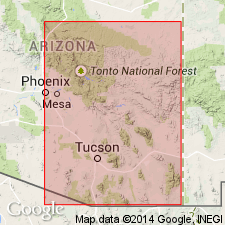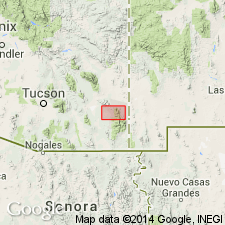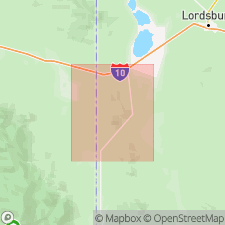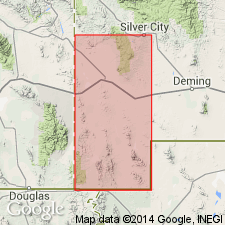
- Usage in publication:
-
- Chiricahua limestone
- Modifications:
-
- Named
- AAPG geologic province:
-
- Pedregosa basin
Summary:
Named presumably for Chiricahua Mountains, Cochise Co, AZ. Forms top of Carboniferous sequence. Rests on older Permian Snyder Hill formation. Correlates with part of Kaibab formation. Is in the Pedregosa basin. Is of Permian age.
Source: GNU records (USGS DDS-6; Denver GNULEX).

- Usage in publication:
-
- Chiricahua limestone
- Modifications:
-
- Not used
- AAPG geologic province:
-
- Pedregosa basin
Summary:
Pg. 498. Chiricahua limestone. Concha limestone is undoubtedly same unit which Stoyanow (1926, Amer. Jour. Sci., 5th ser., v. 12; 1936) mentioned from the Chiricahua Mountains and correlated with the Kaibab. He proposed Chiricahua limestone for these beds, but no type section was ever designated or described, and term has seldom been used by later writers. Suggested that terms Chiricahua limestone and Snyder Hill formation be suppressed and that term Concha limestone be used for the light-colored cherty limestones of southeast Arizona that contain Kaibab fauna and overlie Scherrer formation. Age is Permian.
Source: US geologic names lexicon (USGS Bull. 1200, p. 781).

- Usage in publication:
-
- Chiricahua limestone
- Modifications:
-
- Areal extent
- AAPG geologic province:
-
- Pedregosa basin
Summary:
Extended to Peloncillo Mountains, Hidalgo Co, NM in the Pedregosa basin and used instead of Concha limestone as top formation of Naco group because of priority and because type locality closer. Earlier descriptions by Stoyanow were incomplete so a general description included here. Composed of a thick-bedded, light-gray, medium-grained limestone containing abundant irregularly shaped grayish-pink chert nodules. Chert constitutes almost 50 percent of the rock. Estimated to be 800 ft thick north of Cienega Peak. Overlies Scherrer formation. Is of Permian (Leonard or Guadalupe) age. Is correlative of the Concha limestone of AZ. Geologic map included.
Source: GNU records (USGS DDS-6; Denver GNULEX).

- Usage in publication:
-
- Chiricahua Limestone
- Modifications:
-
- Not used
Summary:
Concha Limestone (Permian, Leonard), upper formation of Naco Group, used in preference to Chiricahua Limestone. Other subdivisions of Naco Group used too. Chiricahua, though the older name, did not have a type locality.
Source: GNU records (USGS DDS-6; Denver GNULEX).
For more information, please contact Nancy Stamm, Geologic Names Committee Secretary.
Asterisk (*) indicates published by U.S. Geological Survey authors.
"No current usage" (†) implies that a name has been abandoned or has fallen into disuse. Former usage and, if known, replacement name given in parentheses ( ).
Slash (/) indicates name conflicts with nomenclatural guidelines (CSN, 1933; ACSN, 1961, 1970; NACSN, 1983, 2005, 2021). May be explained within brackets ([ ]).

